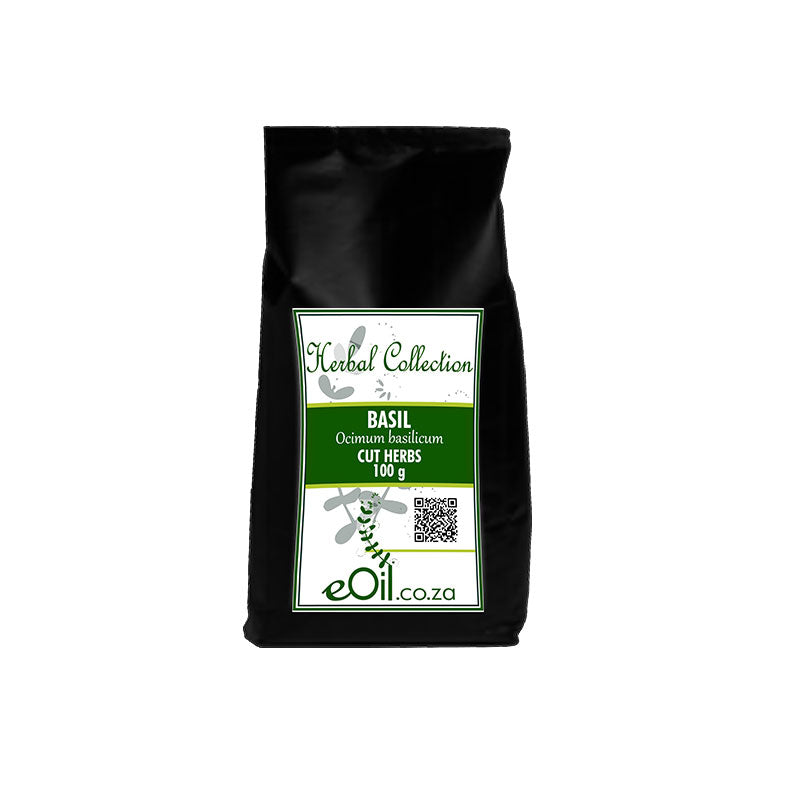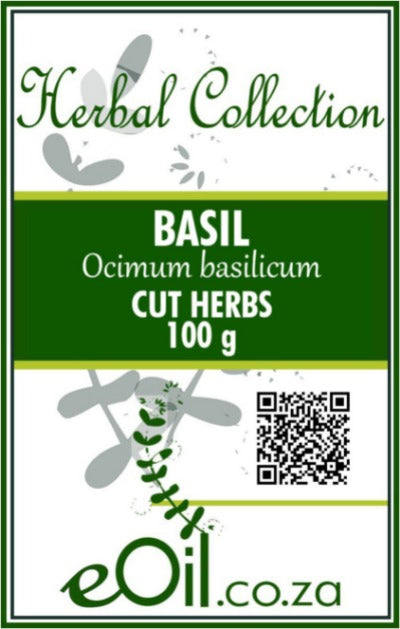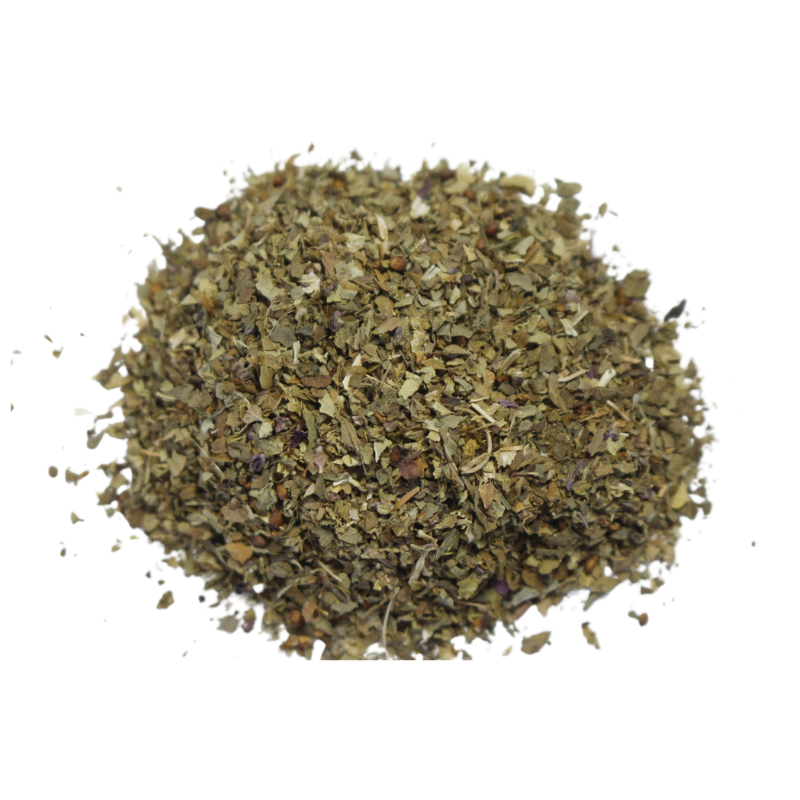Basil Herb Cut - Herbal Collection
Basil Herb Cut - Herbal Collection - 100 GR is backordered and will ship as soon as it is back in stock.
Description
Description
Basil Herb - Ocimum basilicum - Cut offers aromatic, sun-dried basil leaves harvested at peak freshness.
A staple for Mediterranean and global cuisines, this herb brings a sweet, slightly peppery taste to sauces, salads, soups, and seasoning blends.
Perfect for elevating home-cooked dishes with vibrant, natural flavour.
TRADITIONALLY USED FOR
Basil, also known as Ocimum basilicum, is a popular culinary herb that has been used for centuries for both its flavor and medicinal properties.
It is native to tropical regions of Asia and Africa and is now cultivated worldwide.
Here are some benefits, properties, and traditional uses of basil:
- Anti-inflammatory properties: Basil contains eugenol, a compound with anti-inflammatory effects that may help alleviate symptoms related to arthritis, inflammatory bowel conditions, and other inflammatory diseases.
- Antioxidant properties: Rich in antioxidants, such as beta-carotene, vitamin A, and vitamin C, basil helps protect cells from damage caused by free radicals and may reduce the risk of chronic diseases.
- Antimicrobial and antiviral properties: Basil has antimicrobial properties against various bacteria, fungi, and viruses. This can help prevent infections and protect against foodborne illnesses.
- Heart health: Basil contains magnesium, which may help improve blood flow and lower blood pressure. It also has anti-inflammatory and antioxidant properties that can contribute to overall heart health.
- Digestive health: Basil has been traditionally used to soothe digestive issues, such as stomach cramps, indigestion, and bloating. It may also help with gastrointestinal infections and promote a healthy gut flora.
- Stress relief: Basil has adaptogenic properties that can help the body cope with stress. It is traditionally used to alleviate symptoms of anxiety, depression, and mental fatigue.
- Respiratory health: Basil has been used in traditional medicine to treat respiratory issues, such as asthma, bronchitis, and colds. It may help to clear mucus and soothe inflamed airways.
- Skin health: Topical application of basil essential oil or a basil-infused ointment can help treat minor skin irritations, insect bites, and acne due to its antimicrobial and anti-inflammatory properties.
- Immune system support: The antioxidants and other nutrients in basil may help support the immune system and overall health.
INFORMATION
Ocimum basilicum
Source : http://www.wikiphyto.org/wiki/Basilic
Reference on http://www.wikiphyto.org
Translation in English by Google Translate (go to the page of the source linked | on Chrome cellphones go on the 3 dots on the top right and select translate in your preferred language | on laptop right click your mouse and select option translate when hoovering on the page
plant name
Basil, Pistou , Roman Basil
International Latin denomination
Ocimum basilicum L. and its varieties
botanical family
Lamiaceae
Description and habitat
- Annual herb 20 to 50 cm high, with branching stems forming tufts, oval leaves, of a beautiful dark green (some varieties have vinous red leaves, linked to the presence of anthocyanins )
- Flowers yellowish-white to reddish, grouped by 6 in whorls
- Several varieties of basil are grown: the tall green, best known as pistou and the most common, O. basilicum var. Genovese, purple basil O. basilicum purpurascens , lemony O. basilicum citriodorum , Thai basil, O. basilicum var. thyrsiflora , and var. dianatnejadii , ...
History and tradition
- It is the "pistou" of southerners widely used in the culinary arts, it is also the basis of "pesto", an Italian condiment
- Originally from Asia, the Greeks knew it after the campaigns of Alexander the Great
- In the Middle Ages in Europe, it was part of the witchcraft plants
- Basil corresponds to Ocimum basilicum L. but there are different species and cultivars for example European basil ( Ocimum basilicum var. "lettuce leaf") which contains linalool (40-55%) and very little methylchavicol , basil" big green” ( Ocimum basilicum var. “big green”) with mostly methyl-eugenol but 20-25% methylchavicol , etc…
- It is the linalool chemotype European basil which is currently preferred, because methylchavicol is reputed to be carcinogenic, so we avoid the exotic basil or tropical basil Ocimum basilicum ssp basilicum which is rich in this substance
- The mention of the chemotype is therefore important for this plant
- Tulsi or holy basil Ocimum sanctum leaves would be anti-stress but also contraceptive by pituitary route and causes histological changes
Parts used
- dried leaves
- Flowering aerial parts for essential oil
Dosage forms available
- Ocimum basilicum tincture aerial parts
- Flowering aerial parts essential oil
- HE extracted from Ocimum basilicum var. basilicum , tropical methylchavicol (= estragole ) chemotype
- The HE extracted from French basil Ocimum basilicum ct linalool is almost free of methylchavicol
Usual dosages
Composition
Main components of the plant
- Essential oil between 0.02 and 0.70%
- Linalool , methyl-chavicol (= estragole ) majority in the Indian chemotype (up to 90%), eugenol (20%)
- Polyphenols : tannins , flavonoids ( quercetol and kaempferol ), caffeic acid , rosmarinic acid 2%
- Coumarins : esculoside
- Triterpenes ( oleanolic acid , ursolic acid )
Main components of buds or young shoots
Main components of essential oil
- Phenol methyl ether : ME chavicol or majority methyl chavicol , cis-anethole and trans-anethole
- Methyl chavicol is absent or in trace amounts in French basil (aromatic profile with linalool , geraniol , 1,8-cineole , eugenol ) but up to 70-90% in exotic Indian basil
- Monoterpene alcohols : linalool (12-14% and up to 80% in Mediterranean chemotypes), fenchol , terpinene-1-ol-4 , alpha-terpineol , citronellol
- Terpene esters : fenchyl acetate and linalyl acetate
- Phenols : eugenol (1%)
- Eugenol methyl ether
- Ketones : (1%): 3-octanone , camphor
- Oxides: 1,8-cineole , trans-ocymene oxide
- EO analysis of two varieties of Ocimum basilicum var. purpurascens and var. dianatnejadii from Iran (between 0.6 and 1.1% EO ) separated 49 compounds (representing 97–99.7% EO) . The main ones are aromatic compounds (mainly methylchavicol from 34 to 49%) and oxygenated monoterpenes (represented by linalool from 14 to 39%), whatever the variety. Eugenol is only present at less than 1%
Properties
Plant properties
- Antimicrobial [1]
- Antiviral, activity on two RNA viruses: coxsackievirus B1 and enterovirus 71 ( ursolic acid ) [2]
- Stomachic, protection of the gastric mucosa [3] , carminative, appetizer
- Diuretic
- galactagogue
- Antioxidant ( rosmarinic acid ) [4]
- Methyl -chavicol (= estragole ) is toxic and potentially carcinogenic in high doses, but some basil compounds reduce the toxicity of 1'-hydroxyestragole known as a procarcinogen (reduce the formation of DNA adducts) [5]
- The hydro-alcoholic extract of the leaf increases the hepatic content of glutathione-reductase and superoxide dismutase, and detoxification enzymes, anti-cancer (opposes cutaneous papillomagenesis and of the esophago-gastric junction
- The hydro-alcoholic extract is anxiolytic, just like the essential oil [6]
Bud properties
Properties of essential oil
- Anthelmintic, insecticide
- Can be narcotic, positive, powerful antispasmodic, neuro-regulatory
- Anxiolytic [6] (suspicion of cannabinoid properties due to methylchavicol )
- Normalizes the intestinal flora
- Anti-inflammatory, analgesic
- Antioxidant [7]
- Venous and prostate decongestant
- Anti-infectious: antiviral
- Antifungal [8] , [9] , [10]
- Digestive and hepatobiliary tonic
- Antibacterial activity on Pseudomonas sp [11]
- All cultivars have anti-infective, antibacterial and antifungal activity as well as antioxidant activity: Ocimum basilicum var. methyl - chavicol ( estragole ) purpureum ; Ocimum basilicum var. thyrsiflora to linalool (68%); Ocimum citriodorum with nerol (23%) and citral (20.7%)
- The highest antioxidant activity is that of Ocimum basilicum var. thyrsiflora to linalool , which additionally strongly inhibits tyrosinase, whereas Ocimum citriodorum demonstrated the highest antimicrobial activity [12]
Directions
Indications of the whole plant (phytotherapy)
- lack of appetite
- Bloating, flatulence
- Hiatal hernia, esophagitis
- Other Ocimum are gastric protectors
- Poisoning
- Slightly euphoric or even antidepressant properties
Indications of the bud (gemmotherapy)
Specific indications of essential oil (aromatherapy)
- Aerophagia, gastritis, pancreatic insufficiency, nausea, digestive spasms, gastroenteritis
- Travel sickness
- Spasmophilia, multiple sclerosis (?), anxiety, certain depressions, post-infectious asthenia, insomnia
- Rheumatoid arthritis
- Venous circulatory disorders, dysmenorrhea
Known or suspected mode of action
- Methylchavicol (= estragole ) is toxic and potentially carcinogenic
- Rosmarinic acid is antiviral
- Trans -anethole may antagonize thujone
- Eugenol is anticonvulsant and hypotensive by vasodilator effect, parasympatholytic
Usual formulations
Regulations
- French Pharmacopoeia list A (sheet)
Possible side effects and precautions for use
- Carcinogenic risk with estragole and methyl-eugenol
- Not recommended during pregnancy (prohibited for the methyl-chavicol chemotype )
- Skin irritation (dermocaustic) possible in pure form
Bibliographic references
- Go↑ Suppakul P, Miltz J, Sonneveld K, Bigger SW. Antimicrobial properties of basil and its possible application in food packaging. J Agric Food Chem. 2003 May 21;51(11):3197-207. PMID 12744643
- Go↑ Chiang LC, Ng LT, Cheng PW, Chiang W, Lin CC. Antiviral activities of extracts and selected pure constituents of Ocimum basilicum. Clin Exp Pharmacol Physiol. 2005 Oct;32(10):811-6. doi: 10.1111/j.1440-1681.2005.04270.x. PMID 16173941
- Go↑ Akhtar MS, Munir M. Evaluation of the gastric antiulcerogenic effects of Solanum nigrum, Brassica oleracea and Ocimum basilicum in rats. J Ethnopharmacol. 1989 Nov;27(1-2):163-76. PMID 2515396
- Go↑ Jayasinghe C, Gotoh N, Aoki T, Wada S. Phenolics composition and antioxidant activity of sweet basil (Ocimum basilicum L.). J Agric Food Chem. 2003 Jul 16;51(15):4442-9. PMID 12848523
- Go↑ Jeurissen SM, Punt A, Delatour T, Rietjens IM. Basil extract inhibits the sulfotransferase mediated formation of DNA adducts of the procarcinogen 1'-hydroxyestragole by rat and human liver S9 homogenates and in HepG2 human hepatoma cells. Food Chem Toxicol. 2008 Jun;46(6):2296-302. doi: 10.1016/j.fct.2008.03.010. PMID 18433972
- ↑Go to :6.0 & 6.1 Rabbani, M., Sajjadi, SE, & Vaezi, A. (2015). Evaluation of anxiolytic and sedative effect of essential oil and hydroalcoholic extract of Ocimum basilicum L. and chemical composition of its essential oil. Research in pharmaceutical sciences, 10(6), 535–543. PMID 26779273
- Go↑ Seung-Joo Lee, Katumi Umano, Takayuki Shibamoto, Kwang-Geun Lee. Identification of volatile components in basil (Ocimum basilicum L.) and thyme leaves (Thymus vulgaris L.) and their antioxidant properties. Food Chemistry 91 (2005) 131–137 full text
- Go↑ Pascal Fandohan, Joachim D. Gbenou, Benoit Gnonlonfin, Kerstin Hell, Walter F.O. Marasas, Michael J. Wingfield. Effect of Essential Oils on the Growth of Fusarium verticillioides and Fumonisin Contamination in Corn. J. Agric. Food Chem., 2004, 52 (22), pp 6824–6829
- Go↑ SK Oxenham, KP Svoboda, DR Walters. Antifungal Activity of the Essential Oil of Basil (Ocimum basilicum). Journal of Phytopathology, Volume 153, Issue 3, pages 174–180, March 2005
- Go↑ R. Reuveni, A. Fleischer, E. Putievsky. Fungistatic Activity of Essential Oils from Ocimum basilicum Chemotypes. Journal of Phytopathology, Volume 110, Issue 1, pages 20–22, May 1984
- Go↑ Wan J, Wilcock A, Coventry MJ. The effect of essential oils of basil on the growth of Aeromonas hydrophila and Pseudomonas fluorescens. J Appl Microbiol. 1998 Feb;84(2):152-8. PMID 9633630
- Go↑ Avetisyan A, Markosian A, Petrosyan M, Sahakyan N, Babayan A, Aloyan S, Trchounian A. Chemical composition and some biological activities of the essential oils from different basil Ocimum cultivars. BMC Complement Altern Med. 2017 Jan 19;17(1):60. doi: 10.1186/s12906-017-1587-5. PMID 28103929
- Jirovetz, L., Buchbauer, G., Shafi, MP, and Kaniampady, MM 2003. Chemotaxonomical analysis of the essential oil aroma compounds of four different Ocimum species from southern India. Eur. Food Res. Technology. 217:120-124. [1]
- Lachowicz KJ, Jones GP, Briggs DR, Bienvenu FE, Wan J, Wilcock A, Coventry MJ. The synergistic preservative effects of the essential oils of sweet basil (Ocimum basilicum L.) against acid-tolerant food microflora. Lett Appl Microbiol. 1998 Mar;26(3):209-14. PMID 9569711
- Wan J, Wilcock A, Coventry MJ. The effect of essential oils of basil on the growth of Aeromonas hydrophila and Pseudomonas fluorescens. J Appl Microbiol. 1998 Feb;84(2):152-8. PMID 9633630
CAUTION
Store in a cool, dry place, away from light. Keep tightly closed, away from the reach of Children and pets.
Do not exceed the daily dose.
This product is not intended to prevent or cure any form of illness or disease.
If you are pregnant or nursing ; If you have a medical condition or are in the course of medical treatment ; If you are programmed for theater/operation in the near future, please consult your healthcare practitioner before using this product.
This product cannot replace a varied and balanced diet and a healthy lifestyle.
This product has not been evaluated by the SAHPRA for its quality, safety or intended use.
For More Information please check our General Safety Herbal products Page

Basil Herb Cut - Herbal Collection - 100 GR is backordered and will ship as soon as it is back in stock.





